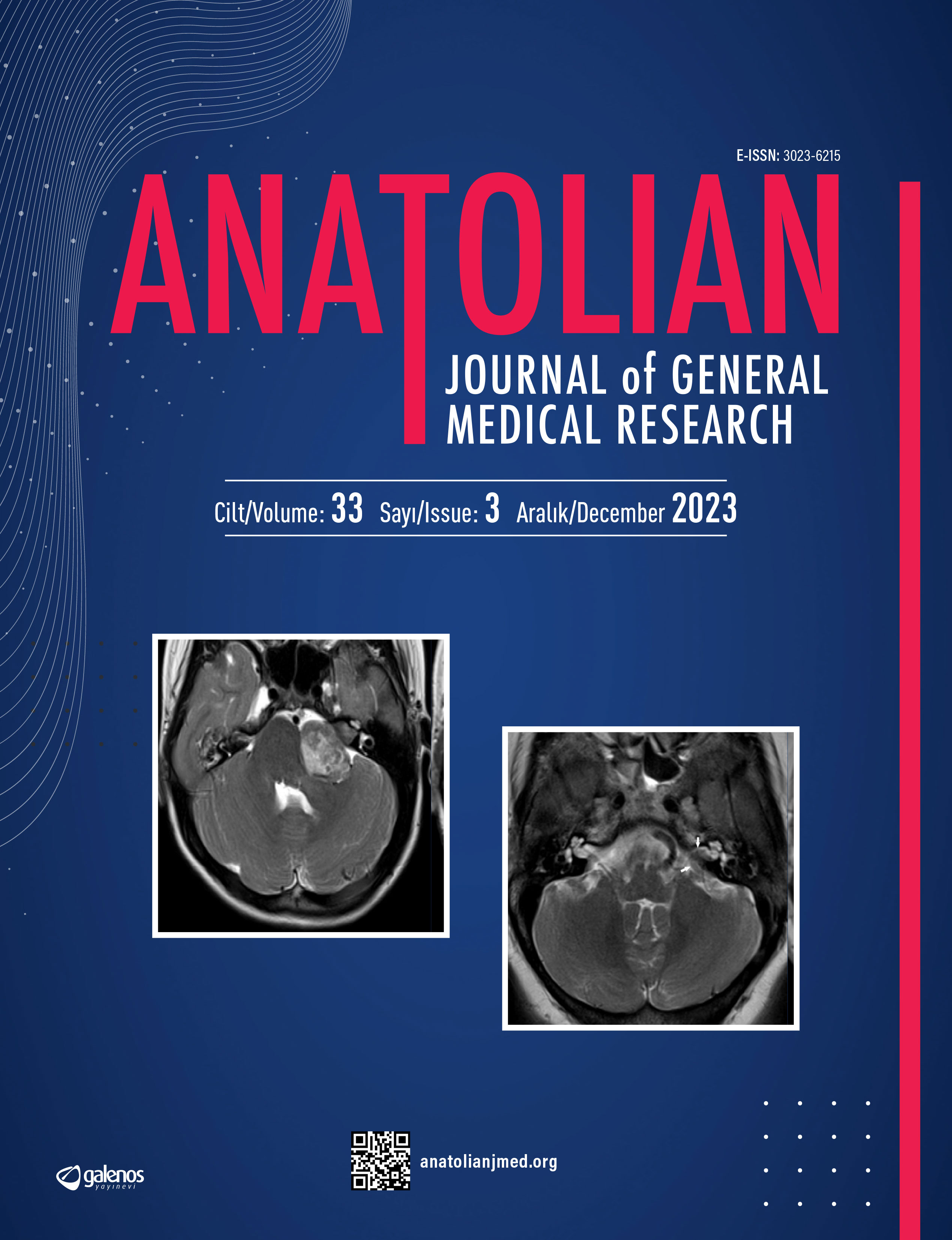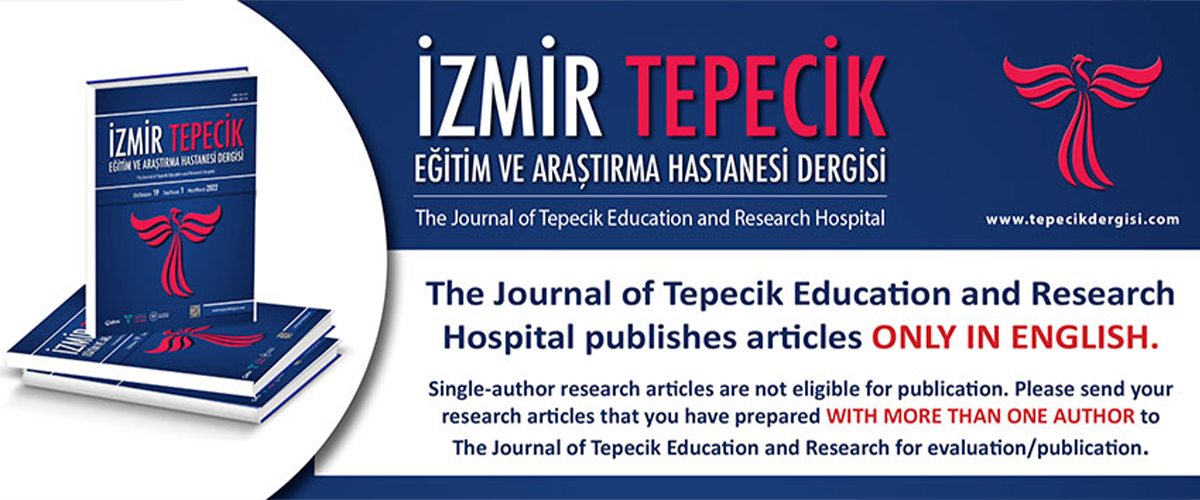








The Role of Serum Transferrîn Receptor in the Diagnosis of Iron Deficiency of Pregnant Women
Berna Atabay1, Işın Yaprak1, Abdurrahman Gül1, Sadık Akşit2, Feyza Umay1, Meral Türker1, Murat Anıl1, İbrahim Yolcu11SB Tepecik Eğitim ve Araştırma Hastanesi Çocuk Sağlığı ve Hastalıklan Kliniği, İzmir2Ege Üniversitesi Tıp Fakültesi Çocuk Sağlığı ve Hastaiıldan Anabilim Dalı, İzmir
Aim: Iron deficiency anemia (IDA) is an important public health problem in pregnancy, especially in developing countries. However, conventional markers for assessing iron status tend to be less reliable in pregnancy. Our aim was to study whether soluble serum transferrin receptor (sTfR) could be effectively used or not as a marker for iron deficiency in pregnancy. Methods: One-hundred and sixty-four relatively low- income healthy pregnant women, accepted for term delivery at Ege Gynecology and Obstetrics Hospital, were studied for iron status. The women with thalassemia trait, anemia of other causes, multiple pregnancies and a history of blood transfusion for any reason were excluded. One-hundred and thirty-two subjects were included in the study in the final analysis. Erythrocyte indices were studied with an automatic coulter (Symex SE, 9000). Serum ferritin and sTfR levels were measured by an immunoturbidimetric and nephelometric method (Dade Behring, Dutch) respectively. A serum ferritin level of less than 15 ng/dl was accepted as iron deficiency (ID). In addition to low ferritin level, a hemoglobin (Hb) level less than 11 g/dl were considered as IDA. The pregnant women uuith normal Hb and ferritin levels were evaluated as control group. The data were analyzed on SPSS for Windows (version 10.0). Chi square, Pearson correlation test and one-way ANOVA were used for statistical analysis. Results: The mean age and the gestational age of pregnant women were 26.4±4.7 years and 39.4±1 weeks, respectively. The median number of parity was 2. Seventy-two (52.3%) women had IDA and 15 (13.6 %) had ID. All of the hematological parameters showed statistical difference between the IDA, ID and the control groups, except MCHC (p<0.05). The levels of serum ferritin, sTfR and sTfR index showed statistically significant differences both in IDA and ID groups as compared to control group. Calculated sensitivity, specifity, positive and negative predictive values for sTfR (>1.8 mg/dl) were 70%, 72%, 83% and 55% respectively. Thirty percent of the subjects were not given iron supplementation during pregnancy, and 35% of them did not receive routine prenatal care. Conclusion: From the data in t his study, it can be said that because of the low sensitivity, the measurement of serum sTfR level for the evaluation of iron deficiency in the pregnancy does not provide additional benefit to the conventional serum ferritin measurement. Also, the pre valence of ID and IDA among pregnant women in low socio-economic population in Izmir is very high.
Keywords: Pregnancy, iron deficiency, iron deficiency anemia, sTfR, ferritinGebelerdekl Demir Eksikliği Tanısında Serum Transferin Reseptörünün Yeri
Berna Atabay1, Işın Yaprak1, Abdurrahman Gül1, Sadık Akşit2, Feyza Umay1, Meral Türker1, Murat Anıl1, İbrahim Yolcu11SB Tepecik Eğitim ve Araştırma Hastanesi Çocuk Sağlığı ve Hastalıklan Kliniği, İzmir2Ege Üniversitesi Tıp Fakültesi Çocuk Sağlığı ve Hastaiıldan Anabilim Dalı, İzmir
Amaç: Gebelikte demir eksikliği anemisi gelişmekte olan ülkelerde önemli bir halk sağlığı sorunudur. Ancak, gebelikteki demir durumunun değerlendirilmesinde optimal laboratuvar tetkiki konusunda halen fikir birliği yoktur. Bu çalışmadaki amacımız gebelerdeki demir durumunun değerlendirilmesinde serum soluble transferin reseptörünün (sTfR) kullanılıp kullanılamayacağını araştırmaktır. Yöntem: Çalışmaya SB Kadın Hastalıkları ve Doğumevi Eğitim ve Araştırma Hastanesinde miadında normal doğum yapan 164 gebe alınmıştır. Demir durumu değerlendirilen ve talasemi taşıyıcılığı, sınıflandırılmayan anemi, transfüzyon öyküsü, çoğul gebelikler ve enjeksiyonlu olanlar çalışma dışı tutularak 132 gebe ile çalışmaya devam edilmiştir. Gebelerden doğumdan önceki gün içinde 2 ml EDTA'lı ve 2 adet 2 ml düz kan alınmıştır. Eritrosit indeksleri tam otomatik kan sayım cihazında (Symex-SE, 9000), ferritin otoanalizörede immunoturbidimetrik (Hitachi 911), sTfR düzeyleri ise nefelometrik yöntemle (Dade Behring) çalışılmıştır. Demir durumunun değerlendirilmesinde altın standart olarak serum ferritin düzeyi alınmıştır. Ferritin <15 mg/dl olması demir eksikliği (DE), ek olarak Hb <11 g/dl olması demir eksikliği anemisi (DEA) olarak tanımlanmıştır. Hb >11 g/dl ve ferritin >15 ng/dl olan gebelerin demir durumu normal olarak kabul edilmiş ve kontrol grubunu oluşturmuştur. İstatistiksel değerlendirmede SPSS 10.0 for Windows programında, ki-kare, Pearson korelasyon analizi ve tek yönlü varyans analizi (ANOVA) kullanılmıştır. Bulgular: Ortalama gebe yaşı 26.4±4.7 yıl, ortalama gebelik haftası 39.4±1, medyan gebelik sayısı 2 olup, gebelerin %52.3'inde DEA, %13.6'inde DE saptanmıştır. Kontrol grup ile DE ve DEA grubu arasında ferritin, sTfR, sTfR indeks ortalama değerleri arasında istatistiksel anlamlı fark bulunmuştur( p<0.05). Serum sTfR ve sTfR indeksinin duyarlılık, özgüllük, pozitif ve negatif öngörü değerleri sırası ile %70, %72, %83, %55 ve %88, %79, %89, %77 olarak saptanmıştır. Gebelerin %30'unun demir kullanmadığı ve %35'inin gebelikte hiç kontrole gitmediği saptanmıştır. Sonuç: İzmir'de SB Ege Doğum Hastanesine doğum için başvuran gebelerde DE ve DEA sıklığı oldukça yüksektir. Bu çalışmadan elde edilen verilere dayanarak gebelerde demir eksikliğinin saptanmasında serum sTfR düzeyinin duyarlılığının %70 civarında olması nedeniyle beklendiği ölçüde yarar sağlamadığı söylenebilir.
Anahtar Kelimeler: Gebelik, demir eksikliği, demir eksikliği anemisi, sTfR, ferritinManuscript Language: Turkish
(1789 downloaded)




